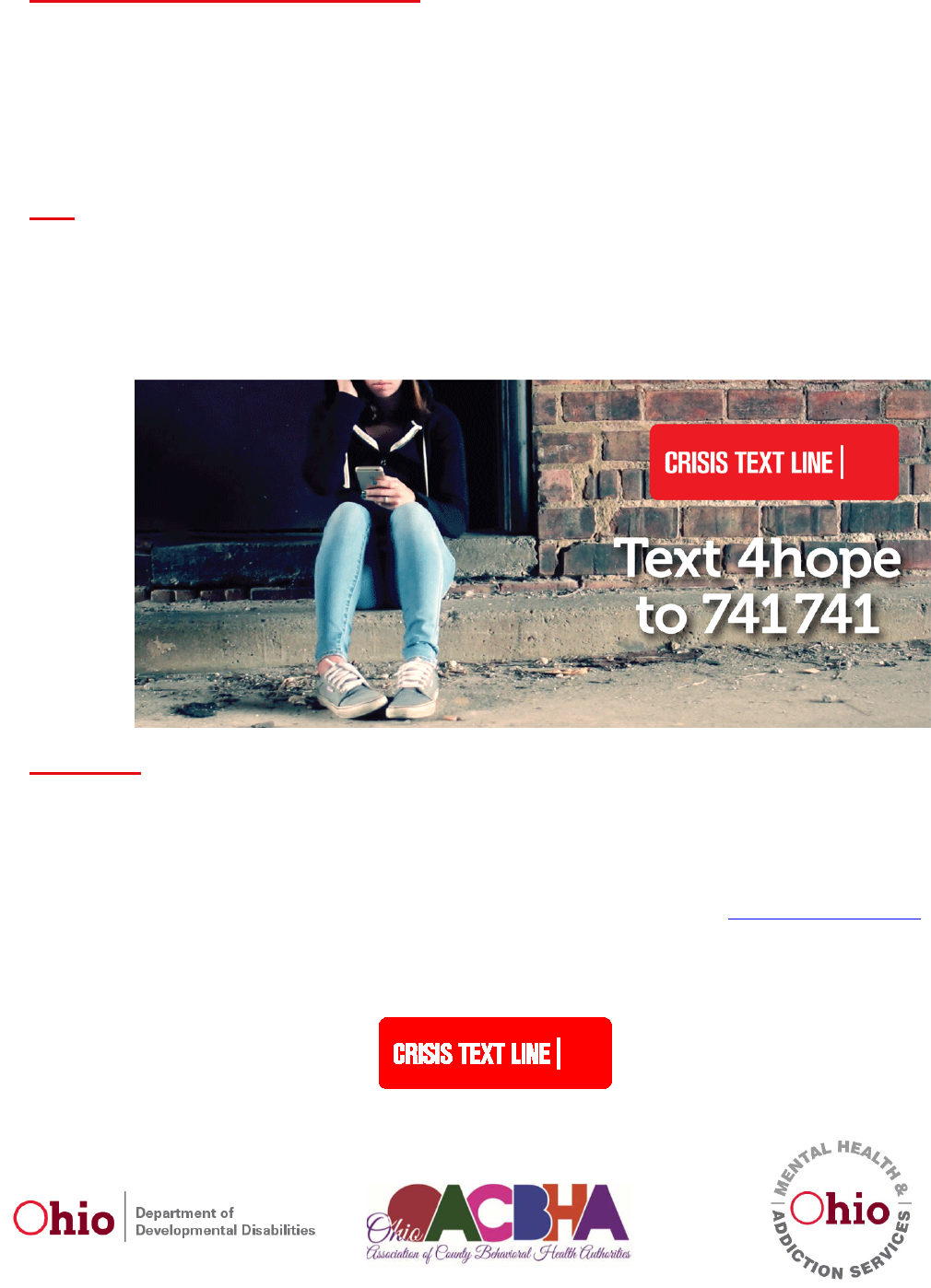
What is Crisis Text Line?
Crisis Text Line provides free support at your fingertips, 24/7. It is a free, confidential service available via text on
mobile devices. It is intended to broaden the options available through current community crisis hotlines. Crisis Text
Line’s goal is to move people from a hot moment to a cool calm.
Message
Any person may need help in coping with a stressful situation. Crisis Text Line believes that everyone who reaches
out for help deserves a human response. No one should feel alone. Crisis Text Line is there any time, day or night,
to help those in need.
How does Crisis Text Line work?
Anyone should feel free to use Crisis Text Line. It serves all ages. An individual may text the keyword “4HOPE” to
741741 and expect a reply from a trained Crisis Counselor within five minutes. The message is confidential,
anonymous and secure. Crisis Text Line does not charge texters if your cell phone plan is with AT&T, T-Mobile,
Sprint or Verizon, and nothing will appear on a phone bill. If your plan is with another carrier, standard messaging
rates apply, and the short code 741741 will appear on your billing statement. An algorithm reviews text for severity
and messages that are determined to be from someone at imminent risk are placed at the top of the queue.
Crisis Text Line in Ohio
The Ohio Department of Mental Health and Addiction Services (OhioMHAS) has entered in to a contract with the
national Crisis Text Line to provide Ohioans with a state-specific keyword to access its free service. Throughout
Ohio, individuals can text the keyword “4HOPE” to 741741 to be connected to a trained Crisis Counselor. This
keyword was originally chosen by the Stark County Mental Health and Addiction Recovery Board. The Ohio
Association of County Behavioral Health Authorities (OACBHA) is working with OhioMHAS to roll out statewide
promotion of this state-specific keyword.
What can I do to spread Crisis Text Line?
Anyone can share the word about this resource with individuals and community members. School personnel, social
workers, treatment providers and media outlets are especially encouraged to promote information about Crisis Text
Line. OACBHA has developed a resource toolkit of digital, print, and physical materials that can enable you to share
the word with your community. Helping spread the word in your community is incredibly valuable.

How can I volunteer for Crisis Text Line?
Crisis Text Line always welcomes new volunteers to be trained Crisis Counselors. To become a trained Crisis
Counselor, you must be over 18. You will go through a rigorous application process that includes a background
check. This is to ensure that the best quality people are on the other end of a text from someone in a Crisis.
Successful applicants will receive 34 hours of web-based training. You may apply through CrisisTextLine.org. There
are over 2,000 trained Crisis Counselors responding to over 50,000 texters per month, and those numbers are
growing every day. On average, there are 10 active rescues each day by trained Crisis Counselors preventing users
from hurting themselves.
Data
All data is auto-scrubbed for personally identifiable information. NO personal information of texters or Crisis
Counselors is shared. CrisisTrends.org shares aggregated data, revealing general trends. These trends include data
by state, by time of day, and by type of crisis. It is, in essence, the world’s first real time data stream for crises, as
well as the world’s largest mental health data set. Universities or research institutions who pass a very rigorous
application process can apply to access a limited subset of enclave data for learning about mental health in general.
Get Started
There are a number of easy ways to get started promoting Crisis Text Line in your community. Some organizations
have put artwork and information on their social media pages. Some have printed out fliers and put them up in their
communities. Some organizations have reached out to schools in their district. It is important to look at the Crisis
Text Line Communications Guide to read about best practices for using the Crisis Text Line logo and how to
approach promoting the service. If you have questions and/or would like to access the Crisis Text Line Ohio
Resource Toolkit that OACBHA has created, please contact Cody Williams at [email protected]
or at (614)
224-1111. Thank you for your interest in sharing Crisis Text Line throughout Ohio!
